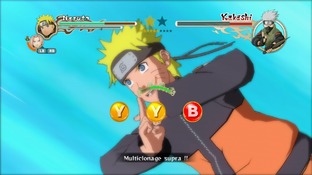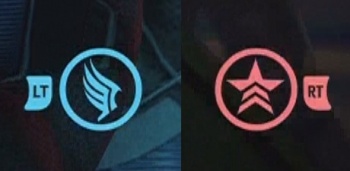
Featured Blog | This community-written post highlights the best of what the game industry has to offer. Read more like it on the Game Developer Blogs.
The Bridge Between Gameplay and Cutscenes: QTEs
Looking at several implementations of QTEs and discussing which of them help enhance the game's mechanics and which distracts from them.

Gameplay and Cutscenes have often been at war with each other, with one providing an interactive experience and the other a passive one. They can both represent large portions of the entertainment in games, but the two forces have been kept separate for several decades. Early games had such weak presentation that cutscenes did not have as large an importance as they do today, so the games that benefited most towards making cutscenes interactive were interactive movies such as Dragon’s Lair where the cutscenes commanded a large portion of the entertainment.
It wasn’t until around the arrival of the Dreamcast that video games no longer need pre-rendered footage to deliver scenes that rivaled films, so making them more dynamic had finally become an option. This is when Yu Suzuki gave us not only Shenmue, but the term QTE (Quick Time Event). After the mechanic was popularized in games like Shenmue, God of War, and Resident Evil 4, its usage in other games dramatically increased to the point where it is now a well-known mechanic and aid for designers in their games.
As the mechanic saw more use, it also saw more misuse, and it really looked like the QTE’s only purpose was that it made everything more interesting. It made cutscenes more like gameplay and it made gameplay more like cutscenes, and it seems that’s all developers really needed to know before they found several different ways to abuse it.
Even as I say that QTEs have been misused, there isn’t currently a “right” and “wrong” way of using them. I would however consider that there are effective and ineffective methods of utilizing QTEs, where the effective methods fully display the engaging potential of the mechanic. While QTEs are implemented in many different ways, there are three categories that seem to represent how they are predominantly used in games today. Two of the three categories represent ineffective usages of QTEs, they are QTEs that make gameplay feel more like a cutscene and QTEs that make cutscenes feel more like gameplay.
When used “ineffectively” QTEs will maintain the disconnect between what is a
cutscene and what is gameplay.
The first category represents QTEs that make gameplay feel more like a cutscene. These are used to give gameplay a cool presentation by allowing the character to perform context-sensitive actions that do not exist within the game’s normal mechanics. This is when the QTEs feel like a mini-game, where the experience feels like a game that is separate from the core mechanics. This is used often in many action games such as God of War when Kratos utilizes flashy finishers on his enemies.
The QTEs in God of War can differ depending on whether Kratos is dealing with a regular foe or a boss. When fighting regular foes his QTEs are simple and often fit with the rest of the gameplay, so he may for instance do a context-sensitive grab on an enemy using the grab button. When fighting bosses however, the QTEs become so elaborate with so many button presses that players see a stark contrast between what they’re doing during those QTEs and their actions during the rest of the game. In addition to the contrast of what they are doing, these QTEs are often mandatory to perform unlike the ones used on regular enemies; this leads the players to see the scripted nature of the event and subsequently associate their actions with “acting out a scene” rather than triumphantly beating a boss. These QTEs consequently create a disconnect between regular gameplay and QTE gameplay, rather than seamlessly creating one unified gameplay experience.
God of War QTE
The second category represents QTEs that make cutscenes feel more like gameplay. These are used in games like Bayonetta and Ultimate Ninja Storm, where it is very apparent to the player that they are interacting with a cutscene. Because these QTEs are used to modify the cutscenes, there is a greater disconnect between the rest of the gameplay than the QTEs in the first category. Again, this disconnect only ends up creating two contrasting types of gameplay instead of one unified experience.

Naruto QTE
When used effectively there should not be a distinction between the cutscene and gameplay, in the context of the QTE they should be perceived as the same thing.
The third category represents QTEs that successfully link gameplay and cutscenes by creating experiences that enhances established gameplay rather than disconnects the player from it. A good example of this are the Paragon and Renegade moments in Mass Effect 2, where the player is able to interrupt cutscenes by performing good or evil options when prompted to on the screen. Making choices in Mass Effect represents a large portion of the enjoyment in the game by allowing the player to alter the story via several options that are usually presented in a dialogue wheel. The QTEs in Mass Effect enhance this mechanic by allowing the effect to happen within cutscenes. Their implementation is slightly different from other dialogue choices since they are timed events that must be performed quickly (see what I did there), but they remain completely optional and end up having the same effect as other conversation options by letting the player shape the story.

Paragon / Renegade QTE
One of my favorite examples of QTE usage comes from Shenmue II. While the QTEs in that game range from extending gameplay in the fight scenes to interactive cutscenes in the chase scenes, there was at least one particular moment that always stood out. There was one scene where Ryo visited a barber who was formerly a martial arts master so that he could learn from him. In an effort to teach Ryo on how to be fearless, he held a razor blade to his neck and told him not to move at all. At this moment a QTE occurs and a button rapidly flashes on the screen, however the player must fight their instincts to press the button in order to pass the QTE. It managed to use the player’s own learned behavior against them; after spending two games teaching players how to quickly press a button to respond to a QTE, they were able to then use that conditioning to create this interesting scene where the only way to progress was to NOT press the button. It's a passive scene where the player's refusal to interact is in fact the interaction, making it both a passive scene and part of the game at the same time.
One game where you can find great implementations of QTEs would be Heavy Rain, as QTEs represent a large portion of both the gameplay and the cutscenes. Almost every action scene is handled through QTEs, and the same goes for the action in the gameplay. QTEs make up the core of the game’s experience and the developers managed to include various implementations of the mechanic. In some instances the QTEs become harder to read depending on how tense the situation is, creating a new experience where the player must attempt to read their options, weight them out, and react to them in a limited time.

Heavy Rain QTE
Not every game can implement QTEs effectively, so it would probably benefit those games to find other methods of creating entertaining moments. The reason QTEs often get a lot of hate when put in games isn’t because the mechanic itself is bad, but rather it’s implementation has often been poor and it only distracts the player from the type of gameplay they really purchased the game for. We will undoubtedly find new ways to implemenet QTEs in games, we should just make sure that we’re doing it with good reason, and not just because God of War does it.
Oh yeah, also don’t use QTEs in fighting games. That’s a rule now.
Read more about:
Featured BlogsAbout the Author(s)
You May Also Like









